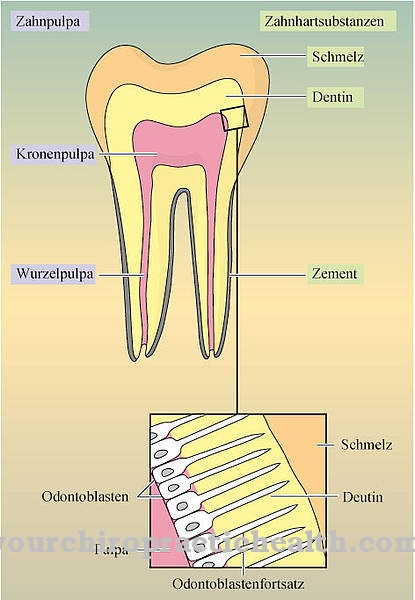As Ovarian follicle Gynecology refers to a unit of female egg cells, epithal granulosa cells and the two surrounding connective tissue lines theca interna and theca externa, which are located on the ovarian cortex in the advanced stage of follicle maturation.
The ovarian follicle and, in particular, its anatomical auxiliary cells take on important tasks in follicular maturation and sexuality, but are also subject to maturation processes that, under hormonal control, trigger ovulation in the late stage and flush the egg cell in the form of the ovarian follicle into the fallopian tube funnel. One of the most important complaints associated with the ovarian follicle is benign follicular cysts, which can form at any stage of follicular maturation and cause the follicle to grow to a follicle size of more than four centimeters.
What are ovarian follicles?
In the ovary of the female body, the egg cell forms a unit with auxiliary cells, i.e. the surrounding follicular epithelial cells, and the two surrounding connective tissue layers during follicular maturation. The doctor knows this unit as the overial follicle, which is sometimes also referred to as the follicle.
The follicles undergo a maturation process under hormonal control, during which the two connective tissue layers and the auxiliary cells of the ovarian follicle are first formed. The resulting ovarian follicles trigger ovulation after they have fully matured. All follicle stages of the ovary are anatomically functional structures that contain especially estrogen-producing cells. Only these cells in turn enable the egg cells to mature and develop.
Anatomy & structure
Ovarian follicles consist of the egg cell, so-called granulosa cells or follicular epithelial cells as well as the two layers of connective tissue theca interna and theca externa. The granulosa cells lie in the multilayered granular layer of the ovarian follicle and develop from epithelial cells of the first stage of maturity, the so-called primary follicle, during the follicle maturation.
The theca interna, on the other hand, is a differentiated border of connective tissue that lies on the ovarian cortex, where it forms the inner cell layer of the ovarian follicle.This connective tissue layer develops into the secondary follicle during the maturation of the primary follicle. The theca externa is also a differentiated border of connective tissue, which develops during the progressive maturation of the follicle and finally lies on the ovarian cortex of the ovarian follicle.
Function & tasks
The ovarian follicles are subject to a maturation process and trigger maturation processes themselves. Even before birth, the woman is equipped with the primordial follicle system, which, in addition to the egg cell, includes a single-layer follicular epithelium. These primordial follicles later continuously increased in size and in the course of this growth develop into primary follicles. The primary follicles arise, so to speak, in the first stage of maturity of the follicle and are equipped with single-layer prismatic follicular epithelium.
Secondary follicles develop from these primary follicles in the subsequent stage. The egg cell is wrapped in glycoproteins in the secondary follicles. The follicular epithelium develops into several layers and aligns itself in the form of rays. The next stage of follicular maturation is that of the tertiary follicle. At this stage, a follicular cavity appears, in which the follicular fluid accumulates. During maturation, this fluid is produced by the granulosa cells of the ovarian follicle, which have developed from the epithelial cells of the primary follicle during maturation. As soon as the egg cell has passed into a cluster of cells, i.e. into the so-called egg mound and thus a docking point, the connective tissue around the cell develops into the two tissue layers theca interna and theca externa. The follicle continues to grow in size and becomes what is known as Graaf's follicle, which is already ready to jump.
These growth processes are controlled by the hormone FSH, which has a follicle-stimulating effect and comes from the pituitary gland. As soon as the hormone FSH and the luteinizing hormone LH are present in a specific concentration, ovulation occurs. With the help of contractile cells of the theca externa, it then flushes the egg cell into the fallopian tube funnel. The majority of the granulosa cells are placed in a protective layer around the egg cell. The vascular and cell-rich connective tissue layer of the theca interna produces androgens during this.
These androgens reach the auxiliary cell-containing layer of the ovarian follicle through diffusion processes, where they are converted into estrogens in aromatization processes. After every ovulation, part of the granulosa cells left behind forms the so-called corpus luteum from stored lipids, which is responsible for the production of the hormone progesterone and controls the sexual cycle. Thus, the ovarian follicles are involved in several processes of hormone production and thus assume control functions in the area of reproduction and sexuality.
You can find your medication here
➔ Medicines for menstrual crampsDiseases
One of the most well-known follicular diseases are follicular cysts. They can arise from the structures of all follicle stages in the ovary, i.e. from any shape of the ovarian follicle in the sense of the maturing egg cell including its shell. As soon as the follicle of any stage of maturity exceeds a size of four centimeters, the gynecologist already speaks of a follicular cyst.
If this process does not occur until after ovulation, the blood-filled, cystic widening of the corpus luteum that is just developing is also called a corpus luteum cyst. Cystic processes are benign tumors that can usually be guessed at by palpation during a routine examination by the gynecologist. Follicular cysts often remain largely symptom-free. The same applies to benign tumors of the ovarian envelope, which develop from superficial cells and often have large masses.












.jpg)



.jpg)










.jpg)
